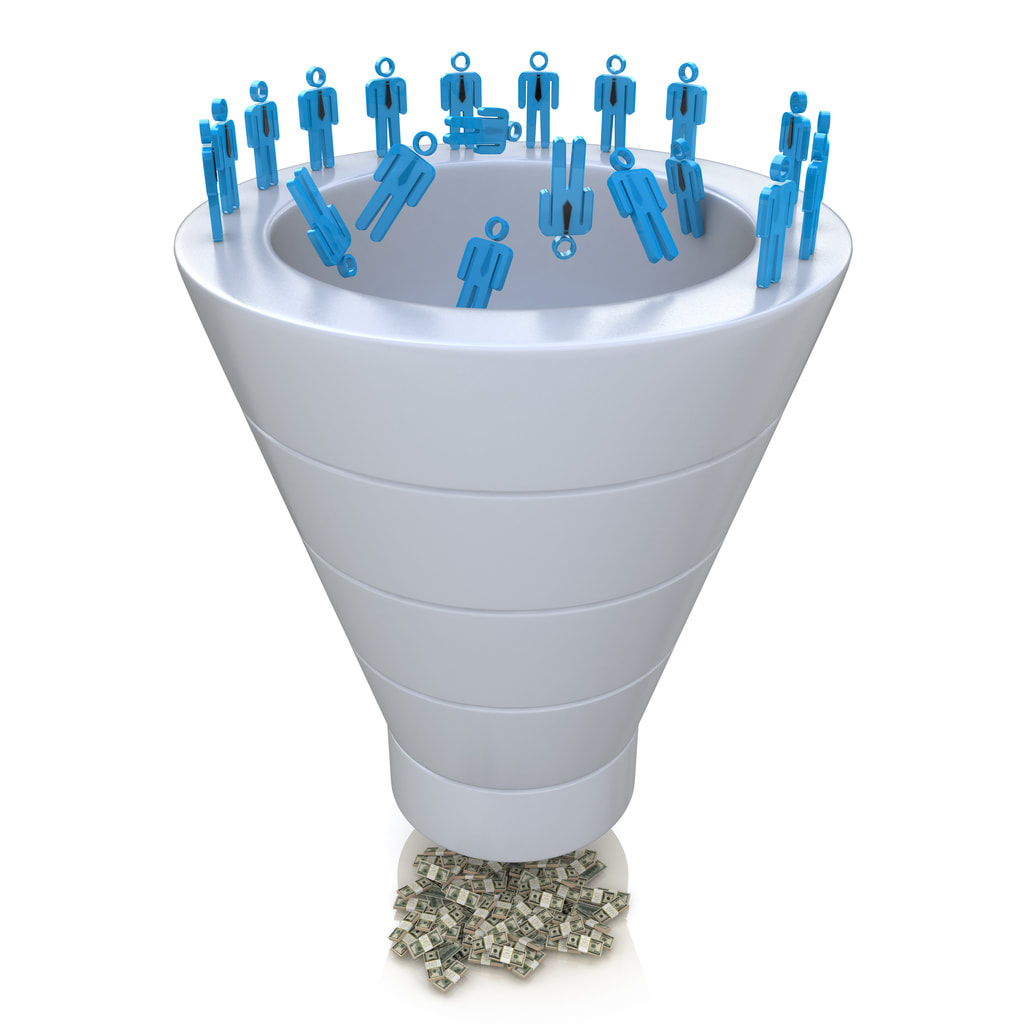 Too often, the concepts of sales funnel and marketing funnel are used interchangeably. The truth, though, is much more complex than that. Each are unique concepts. However, both also have to be integrated with each other for a truly successful sales and marketing operation. That doesn't always happen. We've often worked with clients who have had to close a gap between marketing and sales. Or, they treat the two departments as identical. So, in this post, we'll explain the differences and unique aspects of sales and marketing funnels. And we'll dig into how to make sure both work together for maximum sales and revenue performance. Just the Basics: The Marketing Funnel The marketing funnel drives audiences from the first time they become aware of your brand. They are pushed through whatever process or system marketing has developed to prepare and prime these leads for a transfer to sales. This involves all the steps and stages from bringing the lead into your CRM until they are ready to consider purchasing your product or service. Within that basic definition, the marketing funnel usually includes a few crucial steps as the audience narrows down from your entire potential customer base to marketing and sales-qualified leads:
Just the Basics: The Sales Funnel The sales funnel takes sales-ready leads in the CRM, and drives towards a customer conversion (i.e. a sales transaction). That includes a few important steps to narrow down the audience over time:
Where Sales and Marketing Funnels Intersect Based on the unique processes and differences between marketing and sales funnels, it's tempting to keep the two separate. Unfortunately, that can cause some significant issues. Bridging the gap between marketing and sales is absolutely necessary for a consistent, integrated customer experience. That's especially true because, as clearly distinct as the definitions for each might be, they also clearly intersect. In fact, the bottom of the marketing funnel is typically synonymous with the top of the sales funnel. Marketing often ends with lead generation. But this should not be the case. These leads immediately need to be nurtured, starting with the first email they receive to thank them for their contact information. Interest naturally flows into the more conversion-oriented process. In turn, the sales team looks to engage these leads when they either raise their hand or demonstrate activities that indicate they are primed and ready to interact with the sales team. While the emphasis might be different, it pays to think of the marketing and sales funnels as an integrated whole. They both benefit from one another to maximize opportunity. The whole, in this case, truly does become bigger than the sum of its parts. 5 Opportunities To Integrate Your Sales and Marketing Funnels Fortunately, once the marketing and sales funnels are viewed as a larger whole, integration possibilities become more visible. These five opportunities are especially easy to implement as you look to build a better customer journey for your audience. 1. Sales Insights for Marketing Strategy What does your sales team know about prospects as they move through the funnel? What types of prospects are most likely to convert to customers? Marketing can use this information to better target its efforts, from different demographic targeting to the channels chosen for promotion. 2. Lead Generation and Nurturing Overlaps The traditional marketing funnel ends with lead generation. Conversely, the traditional sales funnel begins with lead nurturing. In reality, though, the two concepts are almost necessarily connected. For audiences, they're likely seen as a single process. Thus, a mutual planning effort to make sure that any lead generation messaging and channel strategy matches with its lead nurturing equivalent is vital for a more consistent, successful strategy. For example, sales teams can call prospects that might not be hand-raised leads yet, introducing themselves and setting the stage for later nurturing efforts. 3. Marketing Content To Improve Sales Efforts The job of the marketing team is not necessarily done when a new lead is generated. Lead nurturing, and even the pitching process, can often benefit from additional resources that marketing can provide to support the velocity of leads moving into and through the sales funnel. For example, blog posts, short videos, or even private LinkedIn groups can all help sales in their efforts to convert new customers. 4. Integrated Messaging Throughout Both Sales and Marketing Integration is the name of the game. And that's especially true for messaging throughout both funnels. Experienced marketers already know that the language and selling points of awareness-based ads have to match up with landing pages, conversion messaging, and more to truly make an audience impact. It's only natural to conclude, then, that this consistency can't stop at the marketing-sales hand-off. The more one core message drives the strategy from awareness to customer conversion, the more convincing that message will become. 5. Comprehensive, Action-Based Insights Finally, sharing analytics and reports can be a significant boon to both marketing and sales in improving their efforts. Insights from sales can help marketing adjust their efforts, while marketing insights can provide a crucial background for sales to optimize theirs. Knowing whether a lead came from social media or a Google search can help to optimize the sales pitch, and vice versa. In short, the natural gap between marketing and sales needs to be as non-obvious as possible for audiences. That's only possible with a direct integration between marketing and sales funnels, all working towards the shared goal of optimizing customer conversions and revenue. If you'd like more insights on how you can improve your sales leadership, contact us. Or sign up for our newsletter for more valuable resources. Comments are closed.
|
Meet Me
Archives
April 2024
Categories
All
|
|
We are headquartered in Colorado with domestic and international teammates and clients. Please use the contact form on this page to inquire about any of our books, podcasts appearances, speaking engagements and workshops, any of our offerings, or simply to connect.
|
© Improving Sales Performance. All Rights Reserved.


 RSS Feed
RSS Feed
